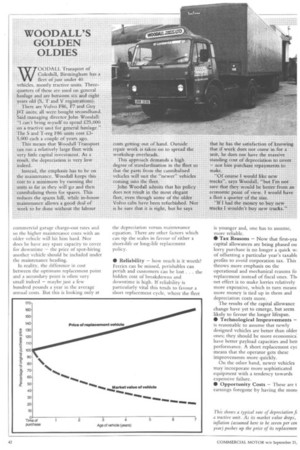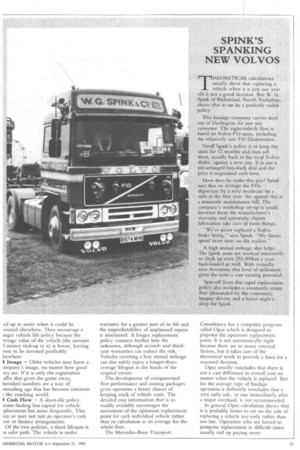TIME FOR A CHANGE?
Page 43

Page 44

Page 45

If you've noticed an error in this article please click here to report it so we can fix it.
When is the best time to change a vehicle? Answers will vary according to application, but there is a method which can give a good indication, as David Wilcox explains
vIOTORISTS replace their cars for all sorts of reasons. Some are pretty subjective; they have t got bored with the car or the ghbours have bought a new C;istered model.
Vehicle replacement in the road nsport industry has to be a more ;ical process. Operators may favour a -ticular method of acquisition or posal, but that still leaves the question timing. When in a vehicle's lifespan is : best time to replace it?
[he objective of any vehicle ilacement policy must be to minimise whole-life cost of ownership. This mediately puts front-end discounts o perspective. An extra one per cent count on a £25,000 tractive unit is
e main depreciation versus maintenance ph: although the top trace shows that the t of ownership is lowest at the end of year ?e, the optimum replacement point is at end of year four when the average annual t is lower.
worth a miserly 50 a year over a fiveyear life.
The two main costs that vary with the age of a vehicle are maintenance and depreciation; an examination of these should form the basis of any replacement policy. Fortunately, they usually move in the opposite direction so that as the vehicle gets older the cost of maintenance grows but the cost of depreciation falls.
The depreciation rate is usually the ' easier of the two factors to predict. Although the state of the vehicle market will affect the residual value, it will almost certainly have a similar effect on the purchase price of the new replacement. It is difficult to buck the market trend: Glass's Guide and the Little Red Book rule OK.
True maintenance costs are not so easy to forecast. Routine maintenance expenditure is predictable but breakdowns, premature component failure and accidents can all throw a spanner in the works.
The graph below shows how maintenance and depreciation costs typically change during the life of a vehicle. The peak in the maintenance trace is a major overhaul at the end of the fifth year.
The important trace is the top one showing how maintenance and depreciation combine. The lowest point on this is at the end of the third year. This is when the cost of ownership is at its lowest, but it is not the best time to sell the vehicle.
What must be considered is the average annual cost of ownership. Six months past the three-year low point this cost is still lower than the average during the first three years; therefore the vehicle should be kept. In fact, the optimum replacement point for this particular example is at the end of four years.
Also noticeable in the top trace is a sharp trough at the end of the sixth year. Having paid for the overhaul in year five the owner gets the benefit of reduced maintenance immediately afterwards.
This secondary replacement point is not quite as good as the optimum one because the high cost of the overhaul has pushed up the average annual costs. But it stands out as a good second best for operators who cannot or do not want to replace their vehicles quite so quickly.
While the depreciation versus maintenance equation always holds good, the respective values of each may vary, moving the cross-over point.
For example, a large fleet operator with extensive in-house maintenance could logically choose to keep his vehicles longer. In-house maintenance should be cheaper and the major overhaul no problem, so the maintenance cost graph chould not rise so steeply with age.
Conversely, the owner-driver with only one vehicle probably has to pay commercial garage charge-out rates and so the higher maintenance costs with an older vehicle will hit him hard. Nor does he have any spare capacity to cover for downtime — the price of spot-hiring another vehicle should be included under the maintenance heading.
In reality, the difference in cost between the optimum replacement point and a secondary point is often very small indeed — maybe just a few hundred pounds a year in the average annual costs. But this is looking only at
the depreciation versus maintenance equation. There are other factors which can tip the scales in favour of either a short-life or long-life replacement policy.
• Reliability — how much is it worth? Ferries can be missed, perishables can perish and customers can be lost . . . the hidden cost of breakdowns and downtime is high. If reliability is particularly vital this tends to favour a short replacement cycle, where the fleet
is younger and, one has to assume, more reliable,
• Tax Reasons — Now that first-yea capital allowances are being phased ou lorry purchase iS no longer a quick w; of offsetting a particular year's taxablt profits to avoid corporation tax. This throws more emphasis on the operational and mechanical reasons fo replacement instead of fiscal ones. Thl net effect is to make lorries relatively more expensive, which in turn means more money is tied up in them and depreciation costs more.
The results of the capital allowance change have yet to emerge, but seem likely to favour the longer lifespan.
• Technological Improvements — is reasonable to assume that newly designed vehicles are better than older ones; they should be more economica: have better payload capacities and ben performance. A short replacement cyc means that the operator gets these improvements more quickly.
On the other hand, newer vehicles may incorporate more sophisticated equipment with a tendency towards expensive failure.
• Opportunity Costs — These are t earnings foregone by having the mom
.ed up in assets when it could be wested elsewhere. They encourage a anger vehicle life policy because the verage value of the vehicle (the amount f money tied-up in it) is lower, leaving lore to be invested profitably Esewhere.
Image — Older vehicles may harm a ompany's image, no matter how good ley are. If it is only the registration affix that gives the game away, herished numbers are a way of oncealing age that has become common the coaching world.
I Cash Flow — A short-life policy leans finding less capital for vehicle !placement but more frequently. This lay or may not suit an operator's cash ow or finance arrangements.
Of the two policies, a short lifespan is le safer path. The vehicle is under warranty for a greater part of its life and the unpredictability of unplanned repairs is minimised. A longer replacement policy ventures further into the unknown, although secondand thirdyear warranties can reduce the risk. Vehicles covering a low annual mileage can also safely enjoy a longer-thanaverage lifespan in the hands of the original owner.
The development of computerised fleet performance and costing packages gives operators a better chance of keeping track of vehicle costs. The detailed cost information that is so readily available encourages the assessment of the optimum replacement point for each individual vehicle rather than its calculation as an average for the whole fleet.
The Mercedes-Benz Transport
Consultancy has a computer program called Opez which is designed to pinpoint the optimum replacement point. It is not automatically right because there arc so many external factors, but it takes care of the theoretical work to provide a basis for a reasoned decision.
Opez usually concludes that there is not a vast difference in overall cost no matter when the vehicle is replaced. But for the average type of haulage operation it definitely concludes that a very early sale, or one immediately after a major overhaul, is not recommended.
In general Opez calculation shows that it is probably better to err on the side of replacing a vehicle too early rather than too late. Operators who are forced to postpone replacement in difficult times usually end up paying more.




































































































